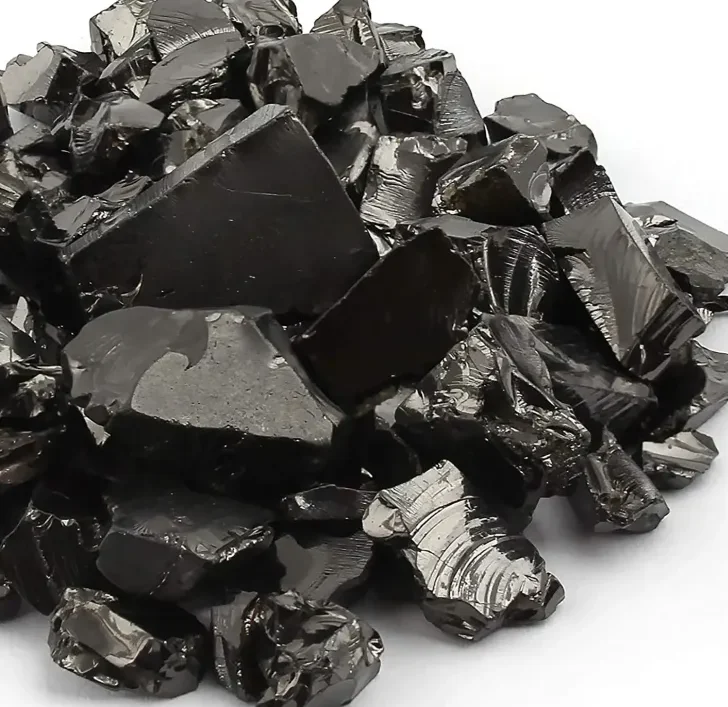
Appearance
Typically, shungite has a rich, glossy black color. Its aesthetic attractiveness can be increased by polishing its surface to a glossy sheen. When polished, shungite’s bright or semi-metallic luster gives it a distinctive and alluring look. Unlike certain other minerals, shungite does not break along clearly defined planes because it lacks a clear cleavage.
Geographical Distribution
Shungite is a quite uncommon mineral that is mostly found in certain parts of Russia, especially the Karelia region. Lake Onega, Karelia, the Zazhoginsky Deposit, Petrozavodsk, and Karelia, Russia, are some important sites and occurrences of shungite. Though minor amounts have been discovered in other parts of Russia, Karelia remains the main source of shungite. These comprise, among other places, the oblasts of Leningrad, Tver, and Vologda.
History
Shungite has a long history in Russia, having been utilized for hundreds of years in a variety of capacities. It was first used in writing in the eighteenth century when Peter the Great founded the first Russian spa in Karelia, which was called “Marcial Waters.” The spa used Lake Onega water, which was said to have medicinal qualities because it had come into contact with shungite rocks. Peter the Great even gave the order to have his buildings built with shungite.
Russian scientists started delving more into the peculiar characteristics of shungite in the 20th century, which eventually led to the discovery of fullerenes within the mineral. The discovery of fullerenes, which are carbon molecules grouped in a special cage-like form, in shungite added to the material’s expanding scientific and practical relevance.
Metaphysical Properties:
Holistic and alternative medicine approaches make use of shungite. Some people think it has therapeutic qualities that can help treat mental and physical illnesses. It can be utilized in meditation exercises, worn as jewelry, or placed close to the body.

Chemical Composition
Shungite is mostly made of carbon, and fullerenes—a particular configuration of carbon atoms—are thought to be responsible for some of its special qualities. Although the precise chemical makeup of shungite varies, it usually consists of a variety of different minerals, trace elements, and carbon. Depending on the type of shungite (Type I, II, or III), the carbon content can vary from roughly 30% to over 98%.
Types
Shungite is divided into three primary categories according to the amount of carbon in it:
Type I Shungite:
With a carbon content that frequently surpasses 98% and a notable concentration of fullerenes, this kind is highly sought-after due to its possible health advantages.
Type II Shungite:
Type II has a lower carbon concentration, usually between 35 and 70 percent. Despite having fewer fullerenes and possibly different characteristics from Type I, it is nonetheless regarded as shungite.
Type III Shungite:
With typically less than 35 percent, this variety has the lowest carbon concentration. Because of its decreased carbon content, it is frequently employed in industrial applications including construction materials and water filtration.
Uses
The following are some typical applications and uses for shungite:
- Water Purification: The purifying properties of shungite are well known. It is employed in water filtration systems to eliminate bacteria, organic compounds, heavy metals, and chlorine, among other contaminants. Shungite filters are used for aquariums and drinking water since they are thought to be effective.
- EMF Protection: Some people think that electromagnetic radiation (EMF) from electronics like computers, Wi-Fi routers, and cell phones can be absorbed and neutralized by shungite. Pyramids, stickers, and Shungite plates are frequently employed for this purpose, albeit there is little scientific proof of their efficacy.
- Protection and Energy Balancing: Shungite is said to offer defense against unfavorable forces and energy. Some individuals surround their homes and places of business with energetic shields made of shungite, which encourage harmony and wellbeing.
- Skin Care: There are skincare and cosmetics products on the market that include shungite. These products might say they reduce inflammation, enhance the health of the skin, and make the skin look younger.
- Antioxidant Properties: Antioxidant qualities are well-known for the fullerenes included in shungite. According to certain research, fullerenes may improve general health by assisting in the elimination of free radicals.
- Craftsmanship and Jewelry: Shungite is a popular material for jewelry, sculptures, and ornamental items because of its appealing appearance and special qualities. Some people think that wearing shungite jewelry might provide protection and healing advantages.
- Construction and Building Materials: Because of its antibacterial and protective qualities, Type III shungite, which has a reduced carbon concentration, is occasionally utilized in building materials like concrete and coatings.
Table





